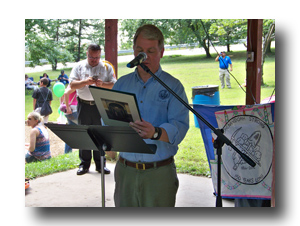|
Follow Sen. Argall on Twitter for Senate happenings –
@SenatorArgall
In this Email Update:
Happy 150th Birthday, Shenandoah!Over the weekend, I celebrated the 150th birthday of Shenandoah with Mayor Andrew Szczyglak and the residents of Shenandoah. Congratulations and happy birthday! You can read more about the celebrations commemorating the borough’s birthday in the Republican Herald. Mahanoy City community welcomes new pumper tanker
Endless recession for rural America?A recent article in Governing, a leading media platform covering politics, policy and management for state and local government leaders, features the struggles of rural America to recover from the Great Recession. The article looks at how rural parts of the country recovered from prior recessions. The article’s author, Alan Greenblatt, interviews several experts from across the country, who provide reasons why rural America continues to struggle to recover from the recession, including: “Urban America recovers from recessions, but rural America no longer seems able to. ‘You look all across this country and some of these places are dying,’ says Seth McKee, an expert on rural politics at Texas Tech University. ‘They’re either going to be wiped off the map, or they’re getting smaller and smaller and there’s nothing to sustain them.’” Greenblatt looks at the economic impact of the decline of the coal industry across the country: “Appalachia itself has been hit hard by the recent steep decline in coal jobs, with production down nationwide by 40 percent since 2008. As working-class jobs have dried up, rural communities have emptied out. Lots of rural towns around the country have come to resemble villages in wartime.” In the article, Eric Schnurer, who is the president of a consulting group for local and state governments, notes that rural communities are largely apathetic to what he calls the “international, networked economy” since they are largely left out of the global economy. However, Greenblatt notes that there is optimism for rural towns with strong leadership looking to the global economy: “Experts in the rural economy say what separates the winners from the many losers is inspired leadership on the ground, whether that’s a plant owner who figures out a way to modernize and stay profitable, or economic development officials able to find a niche by building on successful enterprises or attractions that are already in place.” One quote in the article that jumped out to me was from Rolf Pendall, a director of economic development and housing studies with the Urban Institute. Pendall stated, “If current trends continue, rural America will lose population between now and 2060, even as the country gains another 100 million residents. The people who grow up in these communities who are most capable of having a strong income trajectory, they leave, they go somewhere else.” Despite the difficult odds for many municipalities in our region, I’m always encouraged by the innovation, hard-work and pride in our communities. The two events I mentioned earlier in this email are prime examples of the dedication and tenacity of local residents to make our communities great places to live, work and raise a family. Shenandoah, in particular, is one of the longest tenured communities in the state in the Main Street program. According to the Pennsylvania Downtown Center, Main Street is a comprehensive, community-based approach to revitalizing downtowns and central business districts, which has been applied across the United States since the early '80s. These programs are vital for our region to grow local jobs and create new opportunities for local residents. You can read the full article in Governing here. Reduced fishing license prices for Labor DayThe Pennsylvania Fish and Boat Commission (PFBC) is offering a special fishing opportunity to entice adults and kids to fish on Labor Day, Sept. 5. The PFBC has reduced the price of a 1-day adult resident and 1-day adult non-resident license to just $1 for Labor Day. With issuing agent and transaction fees, the total price for the 1-day adult license is only $2.90. Learn more here. PBFC also has a kayak package giveaway on their website. State comparison of education spending per pupilGoverning recently released a national study ranking states that spend the most (and least) on education. Their study looks at several factors of education spending, including revenue available, teacher salaries, employee benefits, cost of living, demographics, class sizes, administrative costs and state and local policies. The data from 2014 show that per pupil spending is $11,009 nationally. According to their study, Pennsylvania spends $13,938, or $2,929 above the national average. You can see the entire list below from Governing.
Read the entire article on education spending per pupil here. | |||
|
If you do not wish to receive this email, click
here
to unsubscribe. |
||||




